
Madcap Cottage's John Loecke and Jason Oliver Nixon explain how to take retail
customers on a journey by showing them something magical with a little theater and a dash of PT Barnum.
In this edition of Design & Designer, Furniture World talks with the creative founders of Madcap Cottage. The definition of ‘madcap’ – capricious and whimsical; amusingly eccentric – epitomizes the imaginative designs of John Loecke and Jason Oliver Nixon, business and life partners. Their meticulous designs overflow with a joyful playfulness that integrates disparate elements (think chinoiserie meets granny with her pugs) into an exuberance of prints and patterns.
Defining the Madcap Cottage
Jason described the genesis of Madcap Cottage. “We didn’t want to create a brand with our names – our names mean nothing. We wanted to create something that folks would have an affinity for, so we cracked open some gin and started writing names in a composition book.
“We loved the throwback quality of ‘Madcap,’ which suggests a certain uninhibited sophistication, paired with the inviting sensibility of ‘Cottage.’ Madcap Cottage is a lifestyle brand spearheaded by us – but it is also a freestanding brand that has much bigger potential than if we had named it ‘John and Jason Oliver'. Plus, there’s a spirit of fun to the Madcap Cottage name, and ‘fun’ is an absolute tenet of the brand.
“We currently have twelve licenses, including fabric with Robert Allen, tabletop with Certified International, flooring with Mirth Studio, rugs with Momeni, furniture with Newport Cottages, lighting with Port 68, wallpaper with York, a window treatment line with Smith & Noble, and we will be launching bedding next year. We also have a party rental line with BBJ Linen. We will soon launch another flooring line, a tile line, performance fabrics, and, a number of upholstered furniture lines.”
Reinventing Décor
“I grew up in a family,” continued Jason, “where the Friday night activity was moving furniture. We lived in a 1920s Mediterranean-style house in Tampa, Florida. The evolution of the décor went through various periods, including Spanish, Dakota Jackson, and Donghia.
“I think that experience – the idea that interiors should feel forever fresh and inviting – ended up informing our work at Madcap Cottage. After college, I was hired by Condé Nast Traveler magazine, and then went to work on other magazines, books, and television. I have always been passionate about storytelling; of capturing a voice and bringing it to life.”
The Everlasting Build
John’s early story was comparable: “I grew up in a family similar to Jason’s, except that our house was constantly under construction, and I spent a lot of time with builders and construction people. I had planned to become an architect, but switched my focus, while attending Iowa State, to major in graphic design and journalism.
“That’s how I ended up in New York, working at House Beautiful, American Home Style, and Better Homes and Gardens. There I met designers, like Thomas O’Brien, Sunny Williams, Charlotte Moss, and many others, who were doing a lot of interesting things in the home product design space.
“Part of my job at these magazines,” John went on, “was styling other designers’ work to have it photographed. That led me to design spaces for friends, which, in turn, led to working with Jason on a house in South Hampton, New York, featured in The Oprah Magazine.”

Joining Forces
Jason picked up the story: “John and I reached a point where we wondered why we were writing about everyone else’s projects. We had read every design book about the famous interior designers of the past, from Billy Haines to Ruby Ross Wood, Dorothy Draper and Nancy Lancaster.”
“When we started our business,” John added, “it was under my name. Later, Madcap Cottage came into being when we decided to transition to creating a lifestyle brand. Our interior design business took off.”
Jason finished: “While we still do interior design, about 85 percent of the business is devoted to creating products that give retailers and their customers an opportunity to bring magic into their homes by using prints and patterns.”
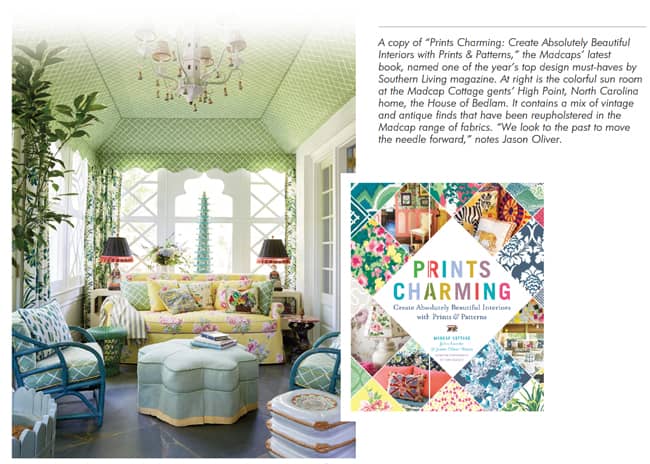
Making It All Work Together
“John and I are simpatico, in terms of our sensibility,” said Jason. “We do have different skill sets: John is an artist, and everything we design he creates. I have a good visual eye, sense of style and proportion. I’m wired to be a kind of Hollywood agent who makes connections. Being partners in life as well as in business, we enjoy a high level of respect and communication.”
John continued, “We’ve always approached product development and licensing with the idea that everything should work and play together. We’ve adopted the ‘Laura Ashley idea’ of the lifestyle brand, which is coordinated, but also lets you do your own thing.
“For example, our Robert Allen fabric patterns were reinterpreted into rugs for Momeni, with coordinating wallpaper with York, plus plates, and even dog collars. Our work is all about prints and patterns.”
Jason remarked, “This gives retailers and consumers the opportunity to really mix and match, because all the greens play together – all of the blues play together.”
Fresh and Exciting Retail
“Today, it’s more important than ever for retailers to tell a story that has an editorial quality,” advised Jason. “When we visit a store like Liberty London, it is forever fresh and exciting. They reintroduce vintage fabrics, recolor them, and then pair them with a modern piece of furniture.
“Marshall Fields was famous for saying, ‘Give the lady what she wants.’ In his Chicago store there were items for five dollars and $500 dollars, but it had a certain magic to it; there was a provenance and a uniqueness. Often, American furniture retailers don’t raise the bar and don’t provide their shoppers with an opportunity to dream.
“Stores like Terrain, part of the Anthropologie Urban Outfitters group, is doing a great job. They sell garden and home decor products. There's a café. It's a wonderful experience. Restoration Hardware delivers the same kind of magic.”
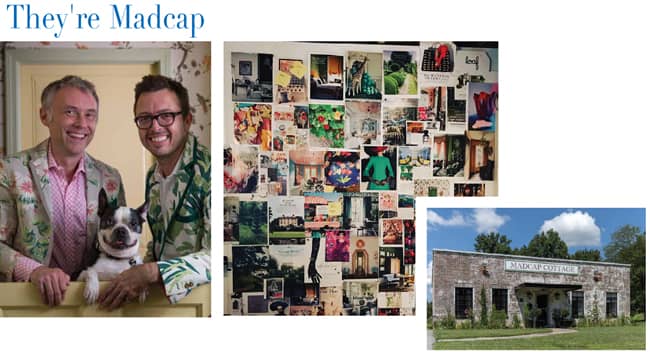
Pictured (left) are John Loecke and Jason Oliver Nixon with one of their pound-
rescue pups, Jasper. The sport coats are crafted from Madcap Cottage fabrics. The Madcap Cottage HQ in Thomasville, North Carolina (right), boasts numerous, ever-changing mood boards (center) that help set the tone for the various Madcap product lines. “We are storytellers,” says John, “and we think in terms of strong visuals and corollary text to bring our vision to life. It’s all about the engagement. We pull images from fashion, travel, and everything else in between to guide our vision.”
|
Keeping it Fresh
John continued, “We spend a lot of time going into stores. There’s a store outside of Atlanta called Fabrics and Furnishings that does a really great job of merchandising and story telling. A store like that can’t compete head-on with the likes of an RH, but they do give people a reason to come back.
“There are still, however, many old-school furniture stores that appear to stock a hundred lines, all jumbled together on the floor. Shoppers have trouble making sense of displays because there isn’t a clear point of view.
“Good retail today is edited. It doesn’t try to be all things to all people. Those stores that want to be all things to all people end up competing directly with Amazon.”
Destination Retailing
“The brilliance of IKEA,” Jason added, “is that a shopper can make a day of it. It’s a destination – a little trip to Sweden where they can buy furniture, stock up on meatballs, have lunch, and buy lingonberries. People feel free to wander, buy items in categories that they might not have even considered. Many furnishings retailers need to learn how to create environments that challenge, tantalize, deliver on service, and feel special.”
John explained, “A big problem with many American retailers is that they are totally consumed with their margins and, as a result, they end up doing long-term damage to their businesses. There’s a cost involved in failing to innovate and challenge customers.”
Where Might Retailers Start
“When I go into a store,” Jason observed, “and sales associates are continuing a conversation among themselves about what they did over the weekend, it feels to customers like the shopping scene in the movie 'Pretty Woman.' Shoppers need to know that retailers care about them and their business. That starts with the greeting, continues with great merchandising, and then needs to be paired with the right service experience.”
John added, “I would start by offering everybody that comes into my store coffee or a bottle of water, just to make them feel at home. It will make them want to stay at least until they finish their coffee!”
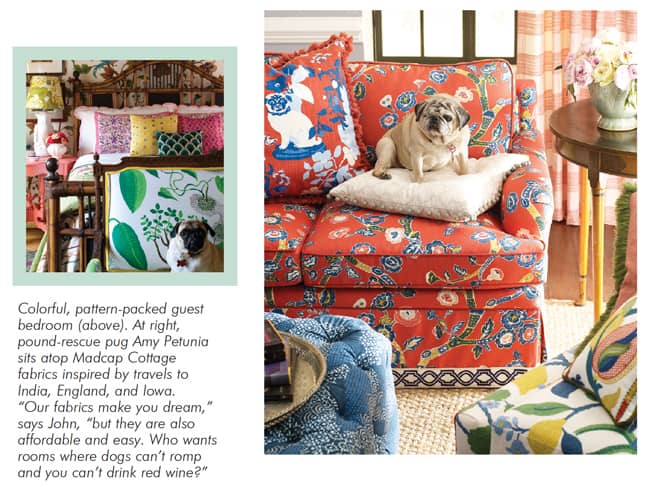
There's a strong trend
toward softer colors, including the Jordon-almond colors of pistachio,
pale pink, and pale blue.
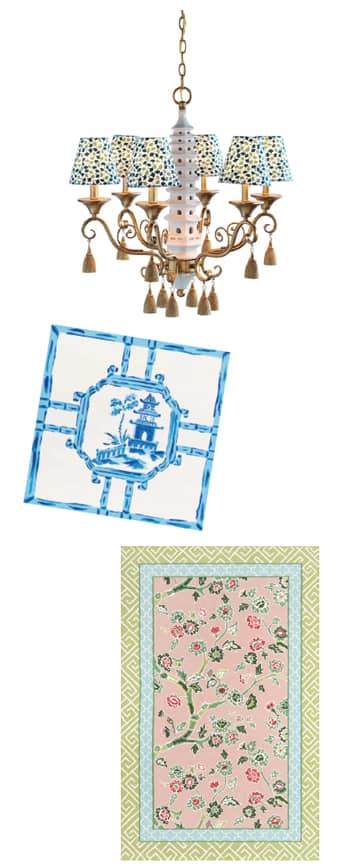
Pictured (top to bottom): The Oh, Pagoda! Chandelier from the Madcap Cottage for Port 68 line with shades crafted from the Madcap Cottage Howards End fabric;
Blue-and-white wood floor tile by Madcap Cottage for Mirth Studio; The Blossom Dearie indoor-outdoor rug by Madcap Cottage for Momeni.
|
Bring Retail Spaces to Life
“Retailers need to create an atmosphere,” John went on, “that includes using wallpaper, props, books and flowers. Many retailers show spaces that are primarily beige, white and blue. We find in our work with design clients that people are apprehensive about bringing too much color and pattern into their rooms. For them, wallpaper can be kind of scary. But once we start working with them to introduce color and pattern, and to show them how it can work, they embrace it.
“But you can’t sell people something that you don’t embrace yourself. And you certainly can’t sell retail customers something that you don’t show them. Our custom line of furniture with Newport Cottages is available in 39 finishes. Are the majority of the orders we get for those pieces going to be in white, grey, or black? Probably. But if we don’t show customers the table in a color, we will never get them to even order it in white, because they didn’t notice it in the first place. Sometimes making a sale is about getting prospects to pay attention. When everything on a retail floor is beige or white or neutral, nothing stands out.”
Creating the Dream
““Even if you don’t sell wallpaper, use it,” Jason explained. “The idea is to make shoppers dream. To do that retailers have to create an environment, a little theater, with a dash of PT Barnum. Take them on a journey by showing them something magical. Anthropologie does a good job in this regard by changing up its mix of antiques, clothing, furniture, and tableware.”
“If you don’t show them anything different,” John interjected, “they’re going to find something similar on Amazon, Wayfair, or in a catalog. You will have lost them – become redundant.”
Jason continued. “I encourage Furniture World readers to shop Calico. Walk into any Calico, whether in Pasadena, Charlotte, or Tampa, and you will encounter a host – a general manager – who runs a tight ship, and sales associates who are attentive, doing a great job of selling furnishings that are totally personal and unique.”
Retail Trend: Sell the Plate
John observed that there has been a return to more defined living spaces. “People seem to want a little more separation again – fewer open-plan layouts where the dining room is part of the living room, which is part of the kitchen. More of these spaces are being designed to meet dual purposes, such as a dining room that also functions as a home office or library space.
“The idea of formality is going away. But that doesn’t mean that retail customers don’t want to buy a nicely upholstered sofa with a traditional shape, or set their tables with attractive dishware."
“Dinner parties,” Jason declared, “don’t necessarily have to happen in the dining room anymore. They can happen in the kitchen, around a game table, or in the living room. People are looking for solutions to facilitate new lifestyles.
““People entertain in a more experiential sort of way. We love Martha Stewart but that doesn’t mean that we want to slave all day making beef bourguignon. People don’t generally have the time or the energy, so dinner might be Bo Jangles chicken served on a beautiful plate. It’s a lifestyle trend that furniture retailers might want to take note of.”
“Prints and patterns are having a big moment,” said Jason. “I think that if retailers look at the broader landscape, they will notice that Cardi B is running around Milan fashion week in head-to-toe floral.
“There’s also a granny-chic trend. House Beautiful just wrote that millennials are embracing needle point, quilts, wallpaper, chinoiserie, and other items associated with grannies back in the day. It’s part of a trend toward creating home environments that look personal and not like a showroom. They include layering, using antiques and vintage pieces.
The important question for retailers is how to educate customers in a way that doesn’t talk down to them.
In other words, help them to embrace new ideas and challenge them to try something different. |
“We are finding, along with granny-chic, there is a strong trend toward softer colors, including the Jordon-almond colors of pistachio, pale pink and pale blue. Also interesting tableware, with patterns including fruits, vegetables and florals. It’s not the soup tureen you remember from 50 years ago; it’s a fresher, more inviting everyday use of table-top, about mix and match, not just fine china.”
Contemporary Still Relevant
John went on, “There’s still a place for contemporary. We are seeing it mixed more often with traditional or mid-century brown wood furniture. For us, mixing traditional with modern art has always made a lot of sense. Now more people are starting to embrace that.
“Especially for millennial buyers, it’s about creating spaces that are personal. They don’t want their living space to look like their parents’ homes. They want something that says, ‘This is who I am, and this is what I believe in.’ Contemporary style has a place in that mix; as does combining people’s personal travel experiences with wider ranges of patterns and prints.”
Sustainable
“Sustainable is a trend, as is the idea of 'made-in-America,'” said John. “People are more willing to wait for something that’s made locally or by hand. That is another view being embraced by millennials who are looking at it from a sustainability and environmental point of view.”
Jason continued. “Sustainability has transitioned more to locally sourced materials, with a parallel trend towards shopping at smaller stores having a distinct point of view.
“It's not about price. There are plenty of made-in-America lines that fit the bill. That is a reason why we pay attention to what’s happening with regard to affordable furniture made in America. Just because something is made in Mississippi does not mean that it has to appear mass-produced and boring. There are vendors there that are doing innovative things on par with European lines.”
There's also a granny-chic trend. It’s part of a trend toward creating
home environments that look personal and don't look like a showroom.
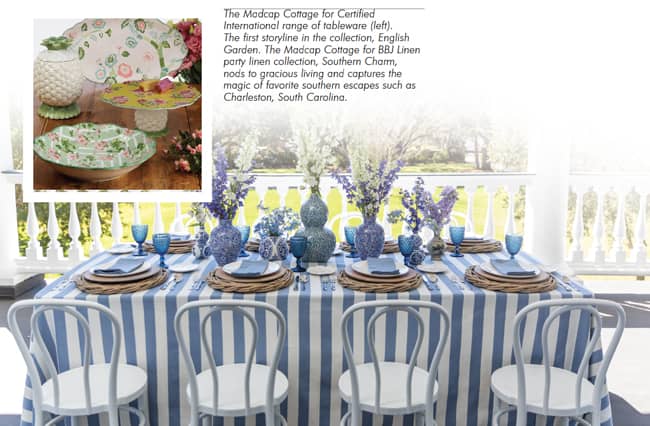
Smart Retailers
“A challenge for the furniture industry,” John explained, “is that consumers don't really know how to get information on the latest trends. So, in the catalog world, instead of just showing products for sale, we are seeing a transition to 'mag-alogs.' They increasingly instruct readers on how to create beautiful rooms. Smart retailers are doing the same thing. The important question for retailers is how to educate customers in a way that doesn’t talk down to them. In other words, how to help them to embrace new ideas and challenge them to try something different.”
Pet Furniture Retailing
In a nod to John and Jason’s four rescue dogs — three pugs and a Boston terrier — John remarked, “Pugs are the new black. We just got back from Europe where we saw crazy dog beds – and not just in gray, beige, brown and blue. We saw tons of floral dog beds and really interesting performance fabrics. It’s a category that sells like crazy, as does lipstick when the economy tanks. My point is that new product and style spaces are constantly opening up as retail opportunities; many of these have already been seen retailing in Europe.”
Long-Range
“Retail has to go back to being fun,” predicted John. “Stores that thrive will be the ones that take the time to develop a compelling point of view, that can help consumers dream about how their homes might be. They have to be edited, feel local, global, and everything in between.
"For Madcap Cottage, we expect to be a larger global brand that has a home base in North Carolina, where you can come and experience the world of Madcap Cottage, complete with a restaurant and hotel.”

Russell Bienenstock is Editor-in-Chief of Furniture World Magazine, founded 1870. Comments can be directed to him at editor@furninfo.com.